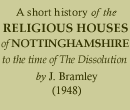< Previous | Contents | Next >
(b) Thurgarton Priory
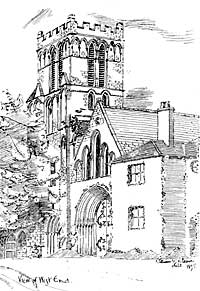 |
| St Peter's Church, Thurgarton. |
This priory of Austin Canons was founded in honour of St. Peter, on the outskirts of the village of Thurgarton, just over three miles south of Southwell, about 1140 by Ralph, second son of the Walter D'Aincourt who came over to England with the Conqueror and from whom he received thirty-four manors in Nottinghamshire, including Thurgarton. Several of the early Charters and other documents relating to Thurgarton have survived, but with one or two exceptions they follow the ordinary run. Dom David Knowles states that about the middle of the 13th century the Prior of Thurgarton received confirmation from his bishop of an annual grant of thirty shillings for the purchase of sweetmeats for the community of the priory as a reward for their agreeing to chant the office more slowly and reverently. In 1284 Archbishop Wickwane issued a decree of imprisonment against one of the Thurgarton canons who had written an abusive pamphlet against him, the nature of which is unknown. In 1286 the Archbishop found the prior guilty of a grave offence and ordered him publicly to purge himself of his sin, and after he had done so he was declared to be of good fame. Four years later one of the canons assaulted a clerk in the church but was eventually absolved. Towards the end of the thirteenth century the prior successfully claimed that his villeins were not liable to do suit at the Wapencourt at Bingham. This must have been in respect of villeins living on priory land in the jurisdiction of the Bingham Wapencourt, as the priory was in the Thurgarton and Leigh Wapentake.
In 1536 Legh and Layton arrived and made very grave charges against John Berwick, the prior, and the majority of his canons, and also declared that eight canons desired to be relieved from their vows. This indictment, therefore, involved nearly all the personnel of the priory, and if a true bill was found it provided good grounds for suppression. Two years after that visit, the prior, the sub-prior and seven canons surrendered the priory, which at that date had an income of £240 a year. But notwithstanding the terrible allegations made against him, the prior was awarded the handsome pension of £40, i.e. £2,000 a year, plus Fiskerton Hall and other lands, while the sub-prior received £6 13s. 4d. a year, and eight canons £5 a year each. This makes us wonder if we can place any reliance on Legh and Layton's allegations.
The priory was bought in 1539 by William Cooper for £510 6s. 8d. plus the manor of Ewell in Surrey, which he held for thirty years. Not much remains of the ancient priory except the undercroft which forms the cellar of the present house and a few wrought stones in the village. Part of the present church formed part of the former priory church.
(c) Shelford Priory
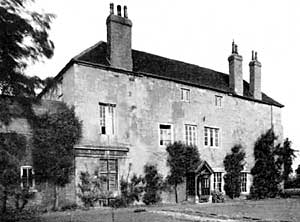 |
| Shelford Manor House. |
This small Austin Priory stood on the south bank of the Trent about six miles north-east of Nottingham.
Ralph Haunselyn or Hauselin founded Shelford Priory in the reign of Henry II (1154-1189), and its history is not in any way remarkable. Just over one hundred years after the Dissolution the house then on the site became the scene of fierce fighting in the Civil War.
Three of the Visitation Reports and one or two Mandates have survived, and one of 1280 by the Archbishop ordered the prior to discard all torpor in spiritual and temporal matters, to discharge certain unnecessary servants, and to refrain from allowing worthless persons to eat and drink at the priory. In the same year a Visitation Report ordered the prior to refrain from indulgence in drink, and gave him many other instructions for amending slackness in the priory. The records show that King Edward II visited the priory in 1317 and again two years later.
When Legh and Layton visited Shelford in 1536 in the course of their evil rounds they estimated the annual income to be £100 and the debts to be £30. They also declared six of the canons to be guilty of grave moral sins, and that three of them desired to be relieved from their vows. They further declared that the girdle of the Virgin Mary and part of a candle which she was said to have carried at her purification were here venerated.
The priory was dissolved in 1536 and Robert Dyxson, the last prior, received a pension of £16 a year.
Archbishop Cranmer asked Cromwell for "the farm of the priory of Shelford" for his brother-in-law, but in 1536 the Crown granted nearly all the manors and advowsons to Michael Stanhope for sixty years at £20 a year and a year later Stanhope and his wife obtained a grant of the site and a good deal of the land on terms unknown. Shelford Manor House now stands on the site of the former priory.
(d) Felley Priory
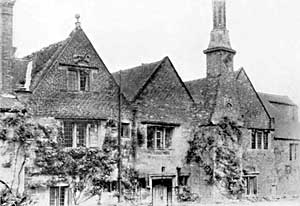 |
| Part of west front of Felley Priory. |
Felley was another small priory of Austin Canons and was founded in 1156 by Ralph Britto of Annesley on the east side of the road from Nottingham to Mansfield via Moorgreen, about ten miles from the county town. The founder endowed the priory with the church and hermitage of Felley, but inasmuch as Felley Church had been given to Worksop (Radford) Priory in 1151, the Pope made Felley Priory subject to Worksop Priory, and it remained so till 1260 when Worksop relieved Felley from any obedience in return for an annual payment of twenty shillings. The agreement embodying this release was witnessed by the Archbishop of York and six abbots and priors. Two priors of Felley became priors of Worksop.
The Visitations disclose nothing special except that in 1276 the prior was deposed by the Archbishop for having assaulted one of the canons and for other irregularities, while three canons were punished for having committed certain offences.
When Legh and Layton visited Felley in 1536 they found the income to be £40 a year and the debts to be £40. The priory was dissolved in that year and Christopher Bolton, the prior, was granted a pension of £6 a year, but it was withdrawn soon after as he was appointed to the living of Attenborough. There were five or six canons.
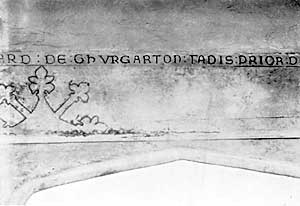 |
| Memorial stone, Felley Priory. |
The priory, site and lands were leased in 1538 by William Bolles, one of Cromwell's Receivers of Monastery properties, but he soon left Felley and it changed hands several times in a comparatively short period. The present house stands on the old priory site and the only considerable relic of the original buildings which now remains, is a wall round part of the garden. A picture of part of the main front of the present house is included here, and shows some of the original stonework; and also a picture of part of what may have been a tombstone of a prior, although he is not recorded as a prior of Felley, now in an upstairs corridor.
